Unexpected, Practical and Green: Lowepro PhotoSport BP AW III Review
For more stories like this, please subscribe to The Phoblographer.
Hiking camera bags are made for the outdoors. But, too often, those bags forget the outdoors when it comes to what they are actually made with. The Lowepro PhotoSport BP AW III is the company’s first bag in a new, sustainable green line. The bag aims to appease outdoor photographers by helping carry gear while also eliminating waste by offering a build that’s 75 percent recycled fabrics. But, can a backpack made from things people threw away protect camera gear and offer quick access?
The PhotoSport BP is a modular camera bag. The camera insert can be removed and attached to the shoulder straps, the waist belt, or a separate camera strap. This would provide easier access and free up space in the actual backpack itself. Besides that, the bag can also clip a camera to the straps, eliminating the need for a shoulder strap. I took the Lowepro PhotoSport BP 24L AW III on a hike to see if the earth-friendly bag is also photographer-friendly.
Too Long, Didn’t Read
The Lowepro PhotoSport BP 24L AW III is a modular camera bag made for hiking. Versatility is key; you can wear the camera on the bag itself, keep the camera insert in its usual spot, or wear the padded camera compartment at your hip. It’s a comfortable, versatile, reasonable, and earth-friendly choice. But, it’s made for just one to two lenses and not big telephotos.
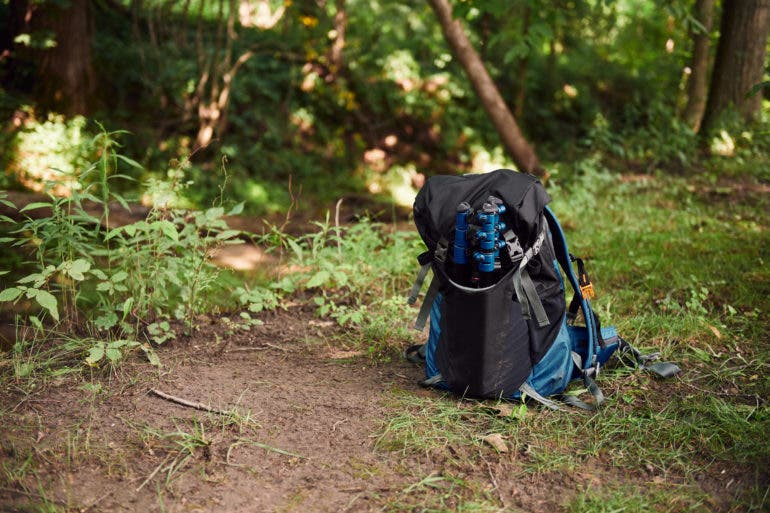
Pros and Cons
Pros
- Modular design, including the option to attach a camera to the shoulder straps and put the camera cube on the waist belt
- Constructed from a green, 75 percent recycled fabric that’s still durable and wipeable
- Extremely lightweight
- Lots of expansion options
- Removable camera cube that blends seamlessly
- The waist belt keeps the weight of camera gear off the shoulders
- Lots of hiking features, including spots for a hydration bladder and trekking poles
- Affordable
Cons
- SD card pockets have no lid, and the waist carry option has no leash or brakes
- Shoulder straps are a little stiff and need to be broken in
- Smaller space for gear won’t accommodate big telephotos and has a smaller access door
Gear Used
I used the Lowepro PhotoSport BP 24L AW III with the Sony a7 III, the Sigma 24-70mm f2.8, and the Zenit 50mm f0.95. I also stuffed the bag with the Manfrotto BeFree travel tripod, a rain jacket, sweatshirt, snacks, bug spray, and a hat, and still had extra room.
Innovations
The Lowepro PhotoSport BP 24L AW III, as the name suggests, is the third generation of a popular hiking bag. But, it’s the first in Lowepro’s new green line and is made of 75 percent recycled fabrics. That’s a great sustainable change, and one that will please outdoor lovers. Besides green construction, the modular design isn’t easy to find among competing bags.
Tech Specs
Lowepro lists these tech specs for the third generation, 24L PhotoSport:
- Weight: 3.31 lbs.
- External dimensions: 10.63 x 8.66 x 19.68 in
- Internal dimensions: 10.24 x 5.12 x 18.90 in
- Camera Compartment Dimensions: 7.09 x 3.94 x 9.06 in
- GearBox Exterior Dimensions: 7.48 x 4.72 x 10.24 in
- GearBox Interior Dimensions: 6.69 x 3.94 x 9.06 in
- Top Compartment Dimensions: 9.84 x 5.12 x 11.02 in
- Primary Device: Camera
- Size: Small, medium
- Device Volume: 5 L
- Exterior Material: 100x300D Nylon
- Interior Material: 200D polyester
Ergonomics

The Lowepro PhotoSport BP 24L AW III is designed for versatility. The bag has three main parts: an expandable drawstring top, an expandable front pocket, and a removable camera cube with side access. The bag also has a spot for a hydration bladder and a tripod along with those three large compartments. Two smaller pockets are hidden inside the top flap and on the waist belt, big enough to fit a smartphone or some filters.

Besides two of the largest pockets expanding, Lowepro offers versatility through attachment points. The bag includes a GearUp accessory strap kit. This kit can be used to attach the camera to the shoulder straps, which has the accessibility of a shoulder strap but with less bounce and nothing pulling on your neck. Or, that strap can also be used to attach the camera insert to the outside front for easier access to lenses or just expanded storage.
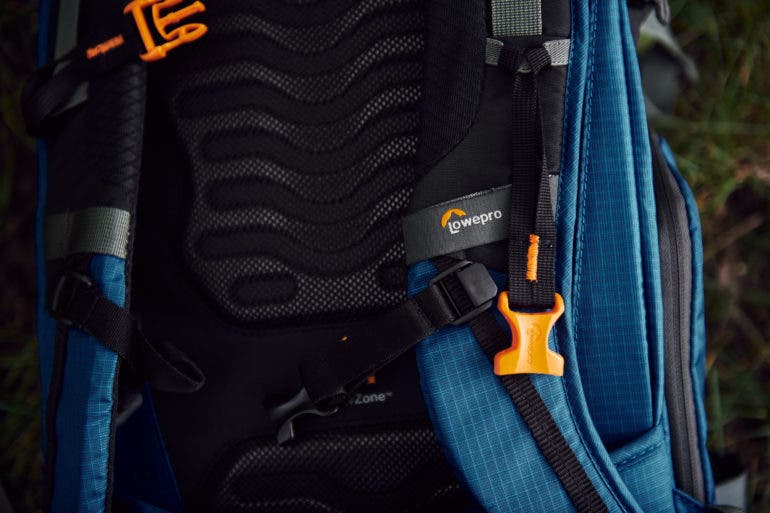
The camera insert can also slide into the waist belt. However, there’s no brakes or attachment point, and if you don’t keep a hand on the belt when taking the pack off, the camera compartment will slide off. There are enough attachment points, however, that I think you could correct this with a carabiner. But I wish it was included in the accessory pack. The accessory kit also has an expanding smartphone pouch that can be attached to one of the straps or worn without the backpack across the shoulder or around the waist.

The top of the bag is a roomy, open compartment with a buckling top flap over a drawstring closure. This expanding pocket is so deep, I can put my arm in up to my elbow. I stashed a sweatshirt and bug spray here, but I could have easily carried more. On the back of this pocket, there’s a mid-sized zippered pouch with a key leash and two smaller mesh pockets. On the front inside, there’s another large pocket to keep bigger items organized.

On the front of the PhotoSport is a large open pocket that allows quick access but is open to the elements. This large pocket can expand a bit with adjustable clips at the top. Big enough for a jacket, you’ll want to pack larger items here that aren’t susceptible to falling out of the open top. And while it’s not advertised this way, I also put my tripod here. It was snug and secure and kept the tripod’s weight better balanced than the side tripod pocket. Also, on the front of the bag, there are four loops for holding two trekking poles.

Sitting on the right-hand side of the bag (when worn) is a pocket for a water bottle or a small to a mid-sized tripod. This pocket is a bit snug, but that meant my 20-ounce water bottle wasn’t going to flip out. My BeFree tripod also fits here, as well as a larger 32-ounce water bottle. The same straps that adjust the front pocket can also help hold the top of a tripod in place.

On the opposite side is the door to access the camera gear. This is the size of most quick access zippers, but it’s the only access point for your gear. That would bother me if this bag were made for lots of lenses. But this bag is made for a camera with an attached lens and one extra lens, both of which you can access from a single door. The camera cube can accommodate camera-lens combos up to 9 inches deep. The longest lens needs to fit attached to the camera. Measure carefully if you plan to hike with a telephoto — I could fit a cheaper 70-300mm but not a 70-200mm f2.8.
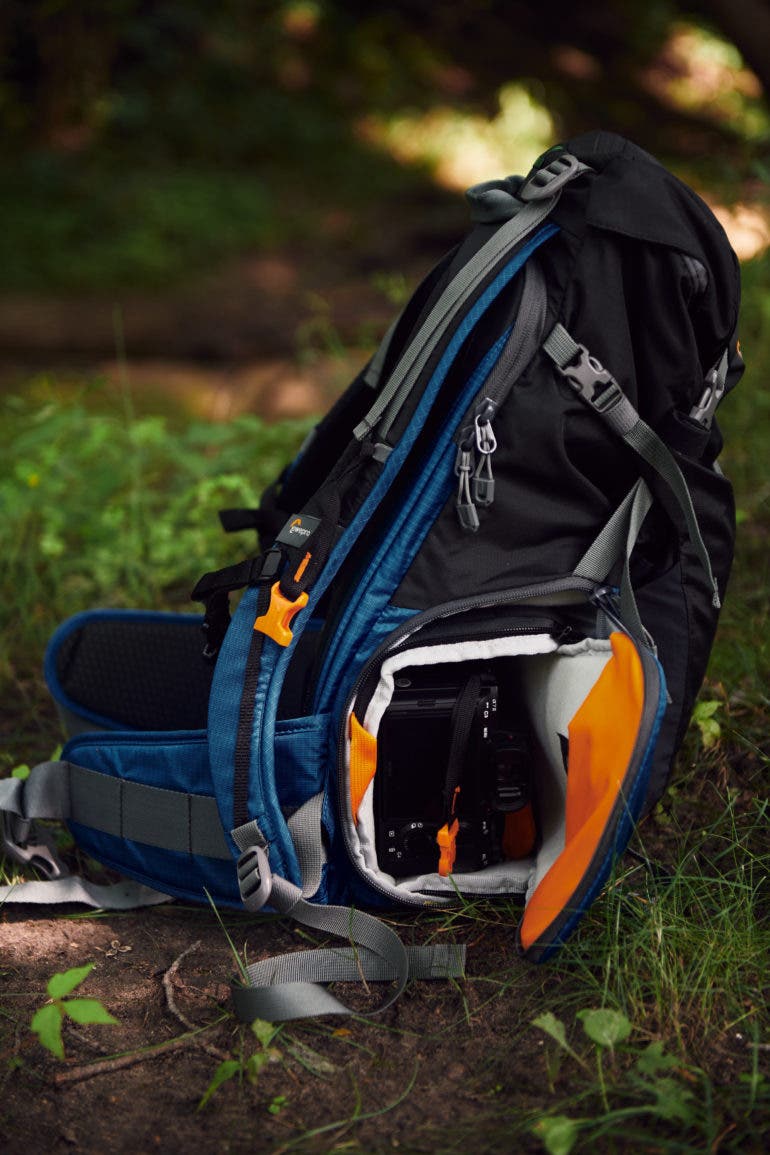
The camera section actually feels like it’s built into the bag, thanks to a pocket in the door that holds the door of the camera compartment out of the way. The entire camera section can pull right out. You can then use the GearUp straps to attach it to the outside of the bag. A zipper that opens two sides allows you to see everything in the camera compartment once it’s pulled out of the main bag.
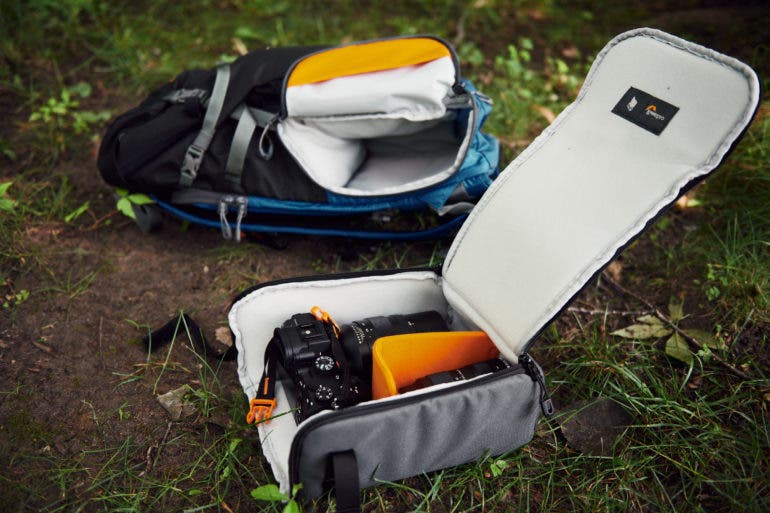
The camera cube is designed to store the camera with the longest lens attached. Then, an L-shaped divider hugs the second lens in the extra room under the camera grip. There’s enough space for a third compartment with shorter lenses. But, it’s not easily accessible without removing the camera cube. A small SD card slot is built into the door of the camera cube. I probably wouldn’t use it as the SD card pocket is open, without a door, and, well, lost SD cards mean disaster.

That brings me to my number one consideration for any camera bag: is it comfortable? The camera gear (presumably the heaviest items in the bag) sitting at the bottom, combined with the waist belt, means the PhotoSport puts more of the weight on your hips rather than your shoulders. This, to me, is much more comfortable than bags that rest the weight on the shoulders and upper back. I wore the bag on an hour-long hike with minimal discomfort.
The shoulder pads are moderately padded and will wear well once broken in a bit. They’re about as thick as the shoulder straps on the Wandrd PRVKE that sits on our best camera backpacks for hiking list, but a little bit stiffer. I’ve used bags with more padding on the straps, like the Mindshift Gear Backlight, but the straps aren’t uncomfortable. Brand new, they’re a little stiff, so the bag should become more comfortable the more it’s used. However, I wouldn’t wear the bag with a tank top since the recycled fabric may chafe a bit against bare skin over long periods of time.
Build Quality
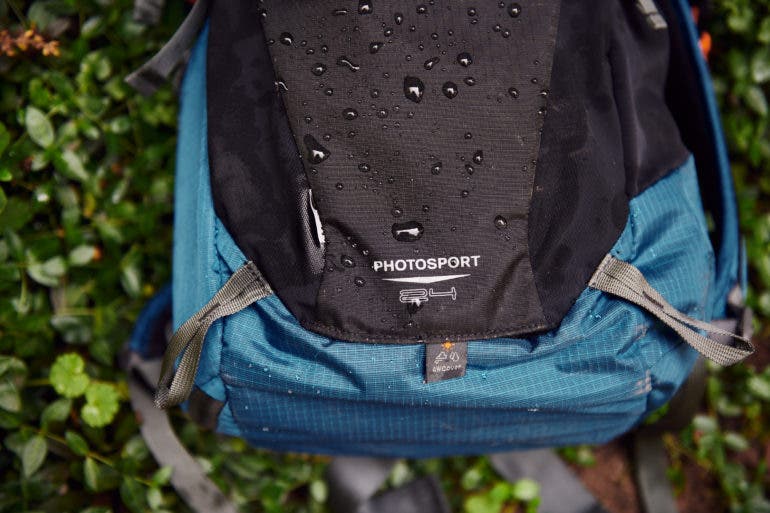
Made from 75 percent recycled fabrics, the Lowepro PhotoSport BP 24L AW III is incredibly lightweight. The bag isn’t going to add a ton to the weight of everything inside it. The fabric has a sporty feel. There is a nice, stretchy mesh at the top of the water bottle pocket and the sides of the expanding front pocket. While it’s not luxurious, it does feel like the material can handle some scuffs and stray twigs. Even the mesh portions feel sturdy and tightly woven.

It wouldn’t be a true hiking bag if it couldn’t withstand the elements, so Lowepro built in a hidden rain cover. Underneath the front pocket, the rain fly pulls out and covers every part of the backpack except the panel that sits against your back. The rain cover is attached with a strap and velcro, so you can remove it if you don’t want to carry it around (not that it adds much weight to the pack).
Ease of Use
The PhotoSport BP 24L AW III isn’t just a camera bag; it’s a camera carrying system. This feature was, by far, my favorite part of the bag. Using the accessory kit included with the bag, you can latch two buckles to the strap loops on your camera. Corresponding buckles loop through the shoulder straps on the bag. This allowed me to carry my camera without a shoulder strap but with the same level of easy accessibility as a shoulder strap. The feature isn’t entirely unique to the PhotoSport — you can pick up options from companies like Cotton Carrier, for example, to add a similar feature to any backpack. But, most of these attachments are holsters, which are not as quick to grab and shoot as this strap. These same straps can also hold the camera cube if you prefer to have your extra lens right at your chest.
While I loved taking the camera’s weight off my neck, I didn’t love the camera strap that’s designed for use when you don’t want to attach the camera to the backpack. This strap wasn’t much more comfortable than the basic straps that come with your camera. If you don’t care for that strap, you may end up unlooping the strap every time you want to shoot without the backpack.
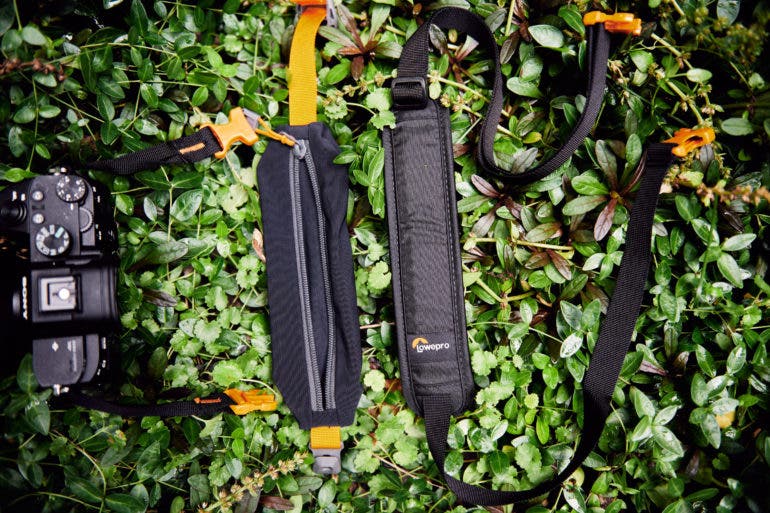
Pulling the bag off to access gear, I had to unsnap the camera on one side, unsnap the chest clip, and swing the bag around to reach the side access door. But, the modular system has an answer for that too. The camera compartment can be looped through the backpack’s belt. That allows you to access all your photo gear without taking the bag off, leaving the backpack for your hiking supplies. Be aware, though, that you’ll want to add a carabiner or something similar to prevent the camera case from slipping off when removing the pack. Using this part of the modular features would have been easier if a leash or more secure attachment had already been included.
With just the small side door, you can only see the end of the camera and the end of the second lens. This would be a deal-breaker if this bag was designed for more than two lenses. But, since I can grab everything from that smaller door, I don’t mind the more limited access. For full access, the entire camera cube can pull out of the bag. If you want to carry more gear or larger telephotos, you’ll want easier access and a bag with a larger area dedicated to cameras and lenses.
Conclusions
Likes
- I love the versatile, modular design.
- It’s built from recycled materials but still feels great.
- This bag is super light.
- The removable camera insert is versatile yet doesn’t get in the way when housed inside the backpack itself.
- The weight is well distributed, with a waist belt to save your shoulders.
- There are lots of hiking features.
- At $230, it’s more affordable than some of the other hiking bags we’ve tested.
Dislikes
- The SD card pocket needs a door, and the waist carry camera insert option needs a hook to prevent accidental drops.
- The shoulder straps are a bit stiff but should wear well once broken in a bit.
- There’s not a lot of room for gear — it’s not a bag for birders with big telephotos.
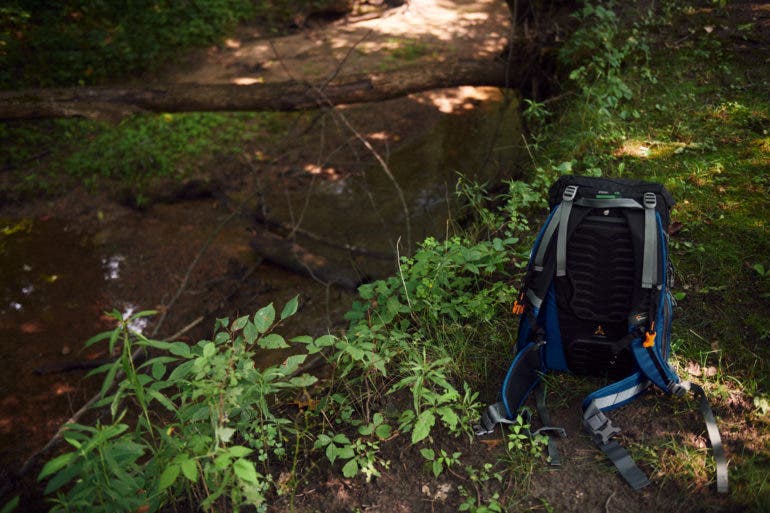
The Lowepro PhotoSport BP 24L AW III is a hiking bag first and a camera bag second. It’s made to carry just a camera and two lenses, photo-wise, but has a place for everything from trekking poles to a hydration bladder, jackets to lunch for hiking. With smart attachment options, the bag can also eliminate the need for a neck strap and keep the extra lens right at your hip. Meanwhile, the top and front pockets expand to hold much more gear.
The shoulder and waist straps are comfortable for day hikes. I’ve used bags with a bit more padding and flexibility to the straps that I preferred a bit more — but all of those bags are more than the PhotoSport’s $230 price point. Considering that everything is included, you don’t have to pay extra to get the actual camera cube or strap attachments — this is a great price point.
The PhotoSport is a good bag for day hikers who have a camera with an extra lens and need a durable, comfortable bag. If you are looking for a versatile hiking bag that’s also lightweight and green-friendly, this is a great option. Keep looking; however, if you want to carry long telephotos, need space for more than two lenses, or want fast access to a lot of photo gear.

I’m giving the Lowepro PhotoSport BP 24L AW III four out of five stars. Want one? Check them out on Amazon!

